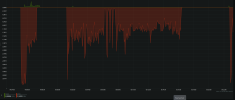Hi,
I am currently testing my RaidZ1 setup.
The plan was actually to create the ZFS pool (4x1TB PCIe NVME SSD) with Proxmox and then pass it as a disk to a VM, among others.
In my benchmarks with fio, however, I noticed that the performance on the host was significantly higher (approx. 50%) than in the VM.
Host (PVE 7.4):
write_throughput: (g=0): rw=write, bs=(R) 4096KiB-4096KiB, (W) 4096KiB-4096KiB, (T) 4096KiB-4096KiB, ioengine=libaio, iodepth=16
write: IOPS=243, BW=976MiB/s (1023MB/s)(858GiB/900075msec); 0 zone resets
WRITE: bw=976MiB/s (1023MB/s), 976MiB/s-976MiB/s (1023MB/s-1023MB/s), io=858GiB (921GB), run=900075-900075msec
VM (Debian 12)
I can't find my results right now, but I did the same fio benchmark here and the write was around 500 MB/s
I then tried a lot of optimizations, such as setting the CPU type to host, disabling aiothreads and specte mitigations, but none of that helped much.
The performance only improved slightly when I changed the block size in the PVE UI to 1MB before creating the VM disk, but even then it was only around 650MB/s
This is the script for my fio benchmark.
The benchmark was running for 15 minutes
I created the ZFS pool and the VM with default settings
create -fo 'ashift=12' testZFS raidz /dev/disk/by-id/nvme-Lexar_SSD_NM790_1TB_NLD648R000186P2202 /dev/disk/by-id/nvme-KIOXIA-EXCERIA_PLUS_G3_SSD_8DSKF3M9Z0E9 /dev/disk/by-id/nvme-KIOXIA-EXCERIA_PLUS_G3_SSD_8DSKF3SLZ0E9 /dev/disk/by-id/nvme-Lexar_SSD_NM790_1TB_NLD648R000184P2202
------------------------------------------------------------------------------------------------------------------------------------------------------------------------------------------------
Does anyone have an idea where the big performance difference between host and VM comes from?
I expected some performance degradation with the VM, but I was thinking around 10%, not 30% or even 50%
------------------------------------------------------------------------------------------------------------------------------------------------------------------------------------------------
In addition, the performance for a Z1 raid also seems very bad to me, when testing the individual disks (only tested on the host) I had about 50% more performance in the same test
But according to this formula, I should have had a factor of 3 higher performance
Streaming write speed: (N - p) * Streaming write speed of single drive
https://static.ixsystems.co/uploads/2020/09/ZFS_Storage_Pool_Layout_White_Paper_2020_WEB.pdf
I am currently testing my RaidZ1 setup.
The plan was actually to create the ZFS pool (4x1TB PCIe NVME SSD) with Proxmox and then pass it as a disk to a VM, among others.
In my benchmarks with fio, however, I noticed that the performance on the host was significantly higher (approx. 50%) than in the VM.
Host (PVE 7.4):
write_throughput: (g=0): rw=write, bs=(R) 4096KiB-4096KiB, (W) 4096KiB-4096KiB, (T) 4096KiB-4096KiB, ioengine=libaio, iodepth=16
write: IOPS=243, BW=976MiB/s (1023MB/s)(858GiB/900075msec); 0 zone resets
WRITE: bw=976MiB/s (1023MB/s), 976MiB/s-976MiB/s (1023MB/s-1023MB/s), io=858GiB (921GB), run=900075-900075msec
VM (Debian 12)
I can't find my results right now, but I did the same fio benchmark here and the write was around 500 MB/s
I then tried a lot of optimizations, such as setting the CPU type to host, disabling aiothreads and specte mitigations, but none of that helped much.
The performance only improved slightly when I changed the block size in the PVE UI to 1MB before creating the VM disk, but even then it was only around 650MB/s
This is the script for my fio benchmark.
The benchmark was running for 15 minutes
Code:
IODEPTH=16
NUMJOBS=1
BLOCKSIZE=4M
RUNTIME=900
#TEST_DIR=/mnt/testLVM3/fiotest
TEST_DIR=/testZFS/fiotest
fio --name=write_throughput --directory=$TEST_DIR --numjobs=$NUMJOBS \
--size=1200G --time_based --runtime=$RUNTIME --ramp_time=2s --ioengine=libaio \
--direct=1 --bs=$BLOCKSIZE --iodepth=$IODEPTH --rw=randwrite \
--group_reporting=1 --iodepth_batch_submit=$IODEPTH \
--iodepth_batch_complete_max=$IODEPTHI created the ZFS pool and the VM with default settings
create -fo 'ashift=12' testZFS raidz /dev/disk/by-id/nvme-Lexar_SSD_NM790_1TB_NLD648R000186P2202 /dev/disk/by-id/nvme-KIOXIA-EXCERIA_PLUS_G3_SSD_8DSKF3M9Z0E9 /dev/disk/by-id/nvme-KIOXIA-EXCERIA_PLUS_G3_SSD_8DSKF3SLZ0E9 /dev/disk/by-id/nvme-Lexar_SSD_NM790_1TB_NLD648R000184P2202
------------------------------------------------------------------------------------------------------------------------------------------------------------------------------------------------
Does anyone have an idea where the big performance difference between host and VM comes from?
I expected some performance degradation with the VM, but I was thinking around 10%, not 30% or even 50%
------------------------------------------------------------------------------------------------------------------------------------------------------------------------------------------------
In addition, the performance for a Z1 raid also seems very bad to me, when testing the individual disks (only tested on the host) I had about 50% more performance in the same test
But according to this formula, I should have had a factor of 3 higher performance
Streaming write speed: (N - p) * Streaming write speed of single drive
https://static.ixsystems.co/uploads/2020/09/ZFS_Storage_Pool_Layout_White_Paper_2020_WEB.pdf


